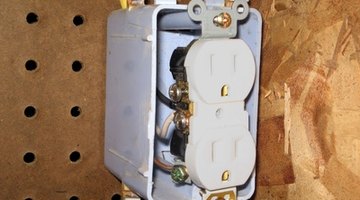How to Figure Out Old Electrical Wiring in My House
Figuring out the wiring system in your house requires a diagram of the floor plan that shows the locations of the electrical panel, any subpanels, and switches, lights and outlets. A basic knowledge of house wiring techniques is needed, and circuits must be analyzed and tested. A separate drawing of the service panel, showing each fuse or circuit breaker, is needed for labeling each circuit.

-
Draw a floor plan of each room in the house that has electrical connections. Include outside porches, storage buildings or garages. Use symbols to identify switches, outlets and lights.
-
Find the main shutoff switch and electrical panel. Locate subpanels, if there are any, and draw a diagram that shows each circuit breaker or fuse in the panel. Mark an identification number or letter next to each circuit breaker or fuse.
-
Turn on all the lights in the house, including lamps that are plugged into wall outlets. Turn off one circuit by switching off the circuit breaker or unscrewing the fuse. All of the lights that go off are on that circuit. Mark that circuit's identification number or letter next to the light or outlet that went off.
Turn that circuit back on, and continue turning off one circuit at a time and marking each outlet or light, until every symbol on the floor plan has a circuit number or letter next to it. Any outlets that are not marked can be identified by plugging in a test lamp and turning off the circuits until you find the circuit that applies to it.
-
Identify the circuits that feed appliances by using the same procedure as above. However, many appliances, such as electric ranges, ovens, air conditioners, heat pumps and water heaters have double circuit breakers or larger plug-in fuses that control these circuits. Some double circuit breakers or larger fuses control wires leading to subpanels. If subpanels exist, use the same procedure to identify the circuits in them.
-
Label each circuit on the electrical panel and keep a copy of your diagram nearby for future reference.
References
Resources
Tips
- Circuit breakers have on/off switches that can be flipped to turn the circuits on or off. Fuses are round, and they must be screwed in or out to turn the circuit on or off.
- Obtaining a copy of the builder's blueprints, with the wiring diagram included, can be helpful for identifying the original electrical system. However, caution is needed, as previous owners of the house might have made unsafe changes that are not shown on the drawings.
- Older houses have many electrical system variations and must be inspected by properly trained and qualified electrical inspectors.
- Figuring out the size and capacity of the electrical service at the building, the system grounding, or the connect/disconnect switch is not covered in this article.
Warnings
- Always take safety precautions and wear proper safety equipment while using hand tools.
- Attempting to work on electrical wires, outlets, switches, panel boxes or other wiring components without complete knowledge of the hazards can easily result in serious injury or death.
- Do not take the cover off of the electrical panel without full knowledge of the potential danger of electrocution.
Writer Bio
Ed English began his writing career with his first book titled "SCUBA Diving A Newcomer's Point of View" published in 2005. English has owned businesses for over 25 years; he holds several certifications from the National Cable Television Institute, Professional Association of Diving Instructors, American Sailing Association and a Home Inspector Certification.
Photo Credits
- electric outlet image by Dawn Williams from Fotolia.com
More Articles



